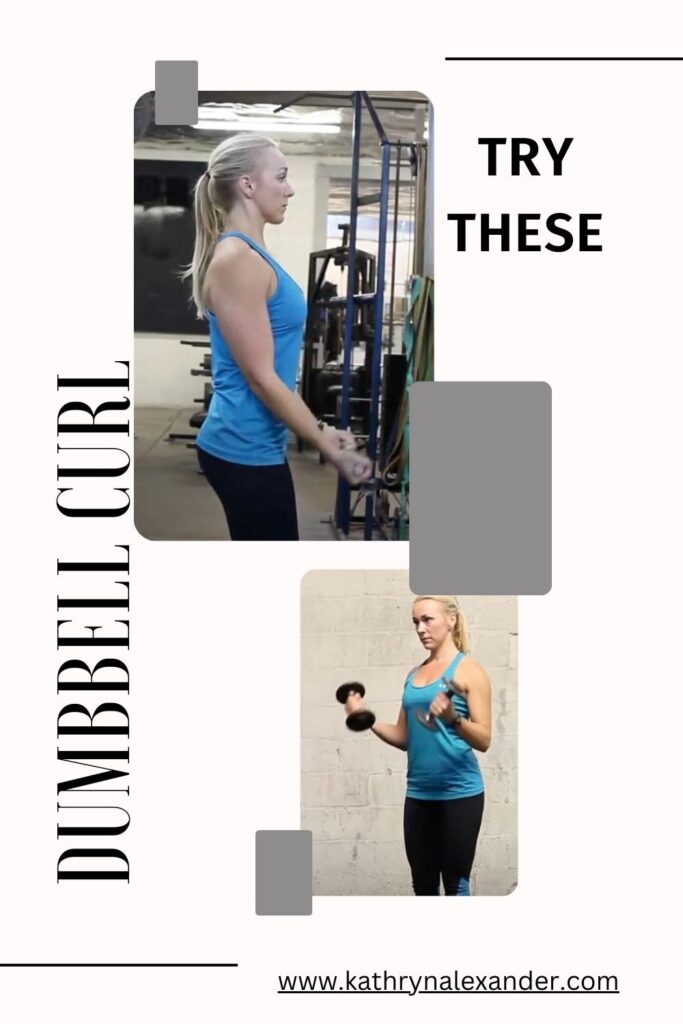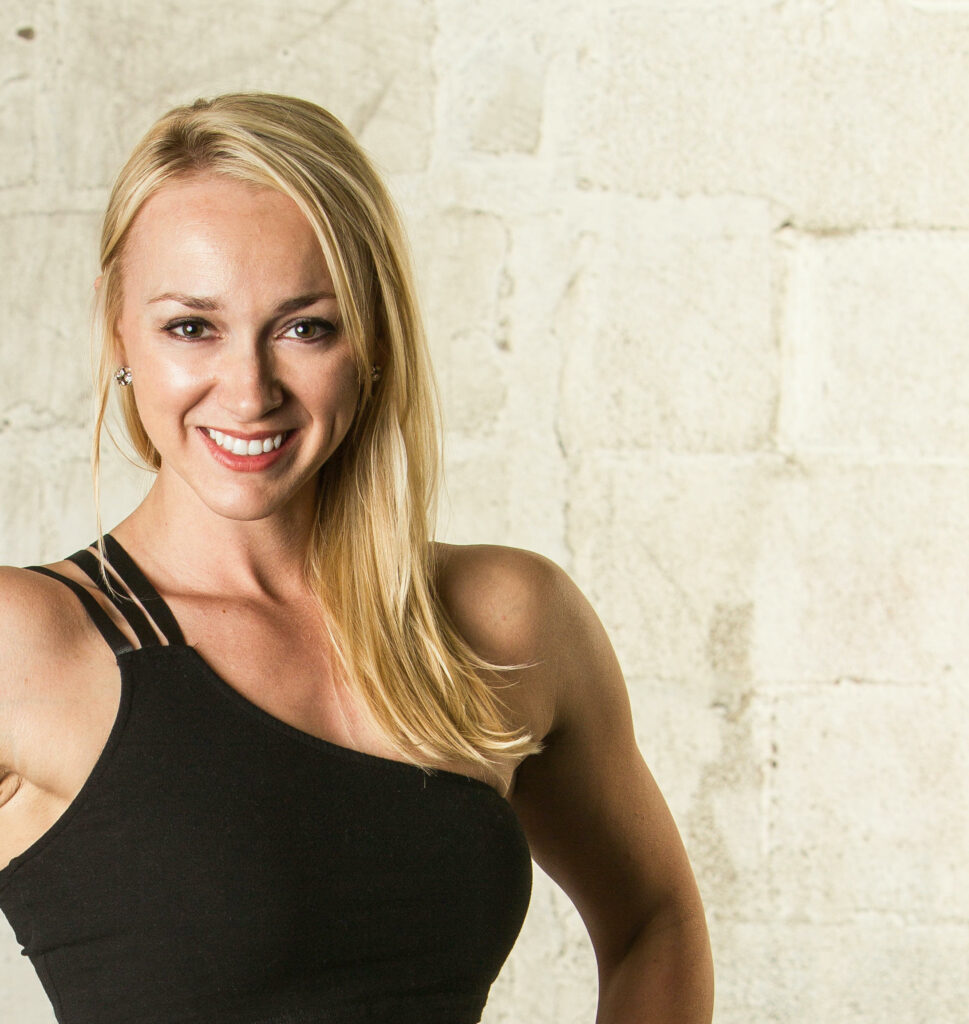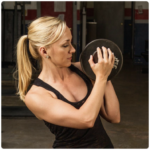Dumbbell curl muscles worked, exercises, and tips on how to maximize your biceps growth for bigger and stronger arms.
Dumbbell curls primarily target the muscles at the front of the upper arm, specifically the biceps brachii. However, they also engage several other muscles to stabilize and support the movement. Here are the main muscles worked during dumbbell curls:
- Biceps Brachii: This is the primary muscle targeted by dumbbell curls. It’s located on the front of your upper arm and is responsible for flexing the elbow joint, bringing your forearm towards your upper arm.
- Brachialis: Located underneath the biceps brachii, the brachialis muscle also plays a significant role in elbow flexion. It helps to add thickness to the upper arm.
- Brachioradialis: This muscle runs along the forearm and also aids in elbow flexion. It’s particularly active during hammer curls but is engaged to some extent during standard dumbbell curls as well.
- Forearm Muscles (Flexors): Various muscles in the forearm, such as the flexor carpi radialis and flexor carpi ulnaris, assist in stabilizing the wrist and controlling the movement of the dumbbell during curls.
- Shoulder Stabilizers: While not the primary focus, the anterior deltoid (front shoulder) and other shoulder stabilizer muscles may also be engaged to some extent to stabilize the shoulder joint and shoulder blades (scapula) during the movement.
Setting the Foundation: Starting Position
The dumbbell curl can be done very strictly, in an effort to make it an isolation exercise. As you become more comfortable and experienced at the dumbbell biceps curl, you can add in some body movement. For now, let’s talk about how to master it at a lighter weight. As bodybuilders say, make light weight feel heavy.

First, stand with your feet shoulder-width apart—this offers a sturdy base that supports a full range of motion. The stance is our foundation; it’s what grounds us and preps our entire body for the work ahead. Alternatively, you can sit on the edge of a bench that allows your arms to extend down by your sides.
Next, let’s talk grip. Hold a pair of dumbbells with your arms straight and palms facing your side. This is your start position. This grip engages the biceps muscles right from the get-go, setting the stage for an efficient curl. Ensure you’re using a weight that allows for maintaining proper form. Later in your lifting career, you can break the rules a little bit.
Lastly, elbow placement is crucial. Keep your elbows tight to the side of your body. Don’t let your elbows pop out to the side of your body or flare out as you initiate movement. If this happens, it’s an indication that the weight is becoming a struggle for you. If you’re at the point where you are wanting to deliberately use swinging, or momentum, you can. But be aware that if your elbows are getting wiggly, and your goal is strict form, you’ll want to drop the weight back down. If you are aiming for biceps isolation, you’ll want to ensure your biceps are doing the work, for the best results.

Executing the Perfect Dumbbell Curl
A traditional bicep curl with dumbbells is typically what we consider a supinated bicep curl. It is probably the most common of the biceps exercises, and for good reason. It’s a great biceps exercise and one I’d like you to master. Step by step directions are below.
- stand tall with abs and glutes engaged
- OR sit on a bench with good posture. No flopping around or lazy sitting
- squeeze your back to secure your shoulders in place
- begin with your palms facing your side
- bend at the elbows and bring the dumbbells in front of you, not moving elbows or shoulders forward or back
- rotate your wrist so your palms are now facing up toward the ceiling
- squeeze at the top
- control the descent
There are variations in wrist position such as with hammer curls or Zottman curls, but the most traditional of curls begin with a neutral grip (meaning palms face each other), and when you supinate as you curl up, you turn your wrists so that it is an underhand grip. There are many right ways to work the biceps, but I just wanted to note that the above directions refer to the most common way.
Avoiding Common Mistakes On the Dumbbell Biceps Curl
Common mistakes people make when doing the dumbbell biceps curl:
- Using too much weight: Many believe that heavier weights guarantee bigger biceps, but this often leads to poor form and decreased muscle growth. Use an appropriate amount of weight that isn’t baby weight but allows you to maintain constant tension on the bicep muscle.
- Swinging the elbows: Keeping your elbows pinned at your side is crucial. Swinging them forward like you’re in a dance contest takes tension off the biceps brachii muscle, hindering growth.
- Losing control at the top of the movement: The temptation to relax at the top can cause you to lose the constant tension needed for muscle growth. Ensure you lower the dumbbells with the same control as lifting them. Don’t just drop them. If you do, you’ll miss all the benefits of the eccentric portion of the life.
- Ignoring the full range of motion: Skipping parts of the movement means you’re not working the muscle fibers effectively. Make sure you fully extend and flex at the elbow joint for the best results.
Variations for Continued Growth of the Biceps Muscles
I cannot stress enough the importance of incorporating various dumbbell curl variations into your routine. By targeting the biceps in different ways, we stimulate muscle growth from multiple angles, leading to better results. Let me share with you a few variations for great biceps workouts.
- Hammer Curls: With a neutral grip, these engage not just the biceps brachii but also the brachialis muscle, contributing to thicker, well-developed upper arms.
- Preacher Curls: By isolating the biceps during the preacher curl, you keep constant tension at the top of the movement, which is crucial for muscle fibers recruitment.
- Concentration Curls: A great way to hone in on the biceps with a mind-muscle connection that’s hard to beat. Each curl done well forces you to maintain perfect form, maximizing muscle growth.
By varying the stimulus, you can ensure continued growth and progress towards achieving bigger biceps. Each variation offers its unique benefits, from improved grip strength to enhanced focus on either the long head of the biceps or short head of the biceps, ultimately leading to stronger, more muscular arms.
Wanna branch out and try a dumbbell shoulder workout at home? Here are some of the best exercises.
Incorporating Equipment and Accessories Beyond Dumbbells
Remember, any movement where you deliberately flex at the elbow will involve biceps. Curls are most commonly done with dumbbells and barbells, but there is a world of different equipment to add in. Barbell curls can be done with different bars, such as thick bars or EZ curl bars. You can use dumbbells, kettlebells, center mass bells, which all still rely solely on gravity.
If you’d really like to vary it up, you can do biceps curls with resistance equipment like cable machines, plate or pin loaded machines, and resistance bands.
With cable machines, you can maintain constant tension on the biceps muscles, stimulating growth from angles dumbbells alone don’t always. The cable machine is really a game changer for helping you maintain time under tension during biceps work. Resistance bands add a varied resistance curve, providing peak tension at the top of the movement. These can really help you maximize the dumbbell curl muscles worked.
EZ curl bars angled grip reduces stress on the forearm muscles and elbow joint, allowing you to focus more on the bicep muscles. These feel more comfortable to many people too. Over the years of training, I have found that many of my clients prefer an EZ curl bar, either on the cable or as a barbell.
By integrating these tools, you’ll engage the biceps brachii muscle (and the other dumbbell curl muscles worked) more comprehensively, building not just bigger, but stronger biceps.
Unleashing Your Arm Potential
Building the full potential of your arms requires a multi-faceted approach, one that goes beyond just curling a pair of dumbbells. Yes, the journey to bigger biceps, stronger forearms, and an you will rely heavily on dumbbell bicep curls, but I encourage you to try other lifts as well. Hammer curls, preacher curls, the Zottman curl, 21’s, etc, all work biceps in different ways, and at slightly different angles.
As you practice these variations, you’ll go from googling dumbbell bicep curls worked to fully understanding how to feel and engage your biceps in many angles and exercises.
Finally, I want you to work other muscle groups too. It’s fun to get a pump in your biceps, but for optimal arm size and strength, and just bigger arms, you’ll want to work triceps too. You’ll even want to work chest, back, shoulders, and even legs for full body symmetry and development.
Let Me Help You!
I know this is a lot to think about, when maybe your most pressing question was which muscles the dumbbell bicep curl works! If you need help finding an exercise solution that works for you, I’d be happy to do a free consult and see if we are a good match. If we are, I’ll make a custom program for you, taking into account your goals, schedule, equipment availability, and exercise background. This can be done with online personal training if you are not in central Texas.
Work With Me!
If you are looking for a personal trainer in Austin, I’d love to talk with you! If you are not in Austin, Round Rock, or central Texas, let’s talk about online training.
Message me here for a free consult about personal training in Austin, Texas, or here for online personal training, and we’ll discuss your goals, background, equipment availability, schedule, and exercise preferences.
Let’s get you strong and healthy! 

About the author
Kathryn Alexander is a strength coach and personal trainer in Austin, Texas. She loves hiking, college football, and the feel of a perfectly knurled barbell. Read more about Kathryn here.






